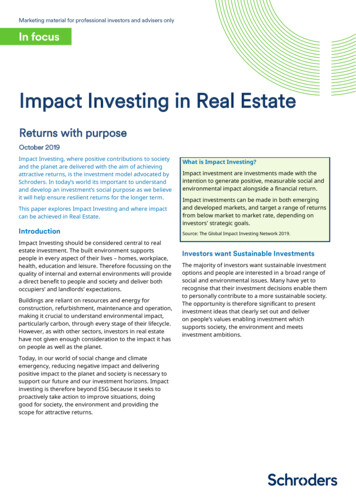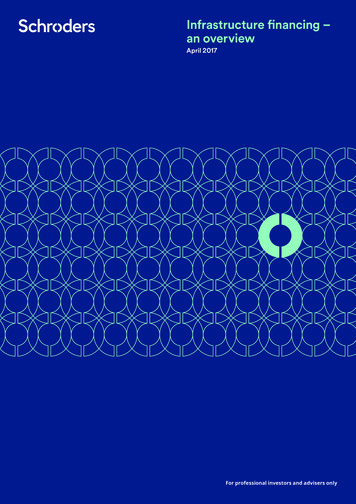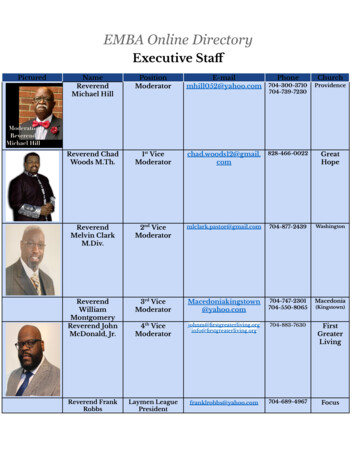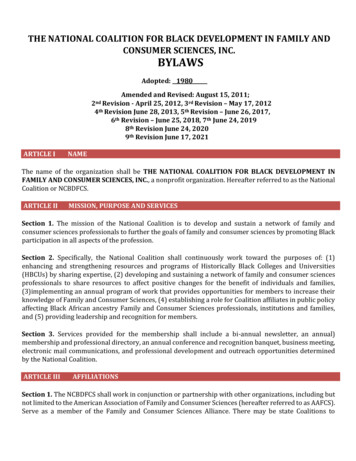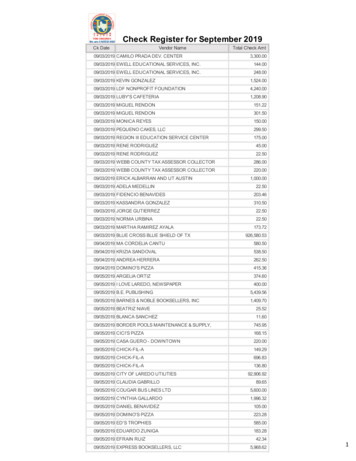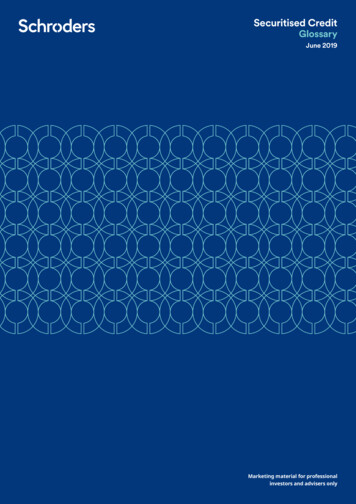
Transcription
Securitised CreditGlossaryJune 2019Marketing material for professionalinvestors and advisers only
Mortgage market terminologyThe below are some commonly-used terms thatdescribe some of the mortgages extended to borrowersor terms associated with the analysis of mortgages.Adjustable Rate Mortgages (ARMs):Mortgages where the interest rate adjustsperiodically, as a spread indexed to anunderlying interest rate (for example, LIBOR 225bps). Rates adjust at pre-definedintervals (for example, three months).Average Daily Rate (ADR): The averagerental income per paid occupied room in agiven time period.Balloon Payment Mortgages: Mortgagesthat do not fully amortise over the lifetimeof a loan, requiring a lump sum due on thelast payment.Collateralised Mortgage Obligation(CMO): Securities that are collateralisedby MBS (see final section). Each CMOhas multiple tranches that have differentexposures to prepayment risk.Commercial Property Price Index (CPPI):A time series of unleveraged US commercialproperty values that captures the prices atwhich commercial real estate transactions arecurrently being negotiated and contracted.Conforming Loan: A mortgage that isequal to or less than the dollar amountestablished by the conforming loan limit setby the Federal Housing Finance Agency andmeets the funding criteria of Freddie Macand Fannie Mae.Fannie Mae (Federal National MortgageAssociation – FNMA): A governmentsponsored enterprise and one of the threeagencies originally founded as part of theNew Deal during the 1930s. Fannie Maeguarantees the MBS they issue. Whilst thesecurities are not backed by the full faithand credit of the US Government they areconsidered to have very high credit quality.Freddie Mac K-Deals (Freddie K):Structured pass-through certificates thatsecuritise multifamily loans.Fully Amortising Fixed Rate Mortgages:Loans that amortise over the life of the loanthrough fixed payments. The fixed paymentgoes towards interest and principalrepayment. Typical term lengths are 15, 20,and 30 years.Ginnie Mae (Government NationalMortgage Association – GNMA): GinnieMae assures the full faith and credit ofthe US government in borrowing andguarantees securities collateralised bymortgages.Government Sponsored Entity (GSE):Financing entities created by the USgovernment to fund loans to borrowers.Fannie Mae and Freddie Mac have receivedthis label as there is an implicit guarantee ofthe MBS they issue.Home Affordable ModificationProgramme (HAMP): A federal governmentloan modification programme introduced tohelp homeowners avoid foreclosure.Home Affordable Refinance Programme(HARP): Created by Federal HousingFinance Agency to allow strugglinghomeowners to refinance without payingmortgage insurance.Home Equity Conversion Mortgage(HECM): A reverse mortgage programmethat allows owners to withdraw equity fromtheir home.Home Equity Line of Credit (HELOC): Aloan in which the borrower uses the equityin their house as collateral.Federal Housing Administration Loan(FHA Loan): A mortgage issued by theFHA geared towards homebuyers with lowcredit scores. FHA Loans have a low downpayment threshold of 3.5% of the totalhome purchase.“Hybrid” ARMs: Mortgage interest rate isfixed for a certain period of time, and thenbecomes adjustable afterwards:Fixed Rate Mortgages with Interest Only(IO) period: The borrower only pays interestfor a fixed period of time, after which theloan payment increases to amortise overthe remaining period.ȂȂ After the fixed-rate period they arecalled “post-reset ARMs.”Freddie Mac (Federal Home LoanMortgage Corporation – FHLMC):A government-sponsored enterpriseestablished to pool single mortgages,providing liquidity to the secondarymarket. Freddie Mac guarantees the MBSthey issue. Whilst the securities are notbacked by the full faith and credit of the USGovernment they are considered to havevery high credit quality.Interest Only (IO): This term can referto the repayment type of a mortgage orit can be a type of Residential Mortgagebacked Securities (RMBS). IO was a commonmortgage type in the UK prior to the GlobalFinancial Crisis. These mortgages don’tamortise, the repayment of the mortgageis (hopefully) covered at maturity by theproceeds of a separate investment accountor by the sale of the home. An IO security iscreated by taking a coupon bearing bondand splitting it into Principal Only (PO) andȂȂ Terms like 5/1 or 5/25 are common todescribe these loans. Fixed for five years,adjustable for the remaining one or 25.ȂȂ Many hybrid ARMs were set up with anIO period. You can therefore have a 5/1ARM with a 10-year IO period.Interest Only securities. The IO cash flowstream only lasts as long as there is principaloutstanding, so it is a bet on prepaymentsbeing as, or slower than, expected.Jumbo Loan: A type of loan where theborrowed amount exceeds the FederalHousing Finance Agency’s limits. Theseloans are not eligible for financing by FannieMae or Freddie Mac.Mortgage Insurance: Insurance paid bythe borrower if down payments of less than20% are made.Mortgage Servicing Rights (MSR): Acontractual agreement where the rights toservice an existing mortgage are sold by theoriginal lender to another who specialises inservicing mortgages.Negative Amortisation Loans (“OptionARMs”): Loans with several paymentoptions available to the borrower (forexample, fully amortising payment, 15-yearpayment, IO payment, or a “minimummonthly payment”).NINJA Loan: A loan extended to a borrowerwith little or no attempt to verify theapplicant’s ability to repay (No Income, NoJob, No Assets).Property Assessed Clean EnergyFinancing (PACE): A means of financingenergy efficiency upgrades, disasterresiliency improvements, waterconservation measures or renewableenergy installations.Private Label Security: MBS that do notconform to the criteria defined by theGovernment Sponsored MBS issuingenterprises.RHS Loan: A type of financing made orguaranteed by the US Department ofAgriculture Rural Housing Service. The RHSlends to low income rural borrowers andguarantees loans that meet RHS standardsby approved lenders.Qualified Mortgages: A mortgage loanthat meets standards for lender protection(ability to repay or ATR) and secondarymarket trading.To Be Announced (TBA): A term describingforward-settling MBS trades. Pass throughsecurities trade in the TBA market and theactual MBS that will be delivered to fulfil aTBA trade is designated 48 hours before theestablished trade settlement date.Veterans Affairs Loan (VA Loan): A homemortgage option available to US Veterans,Service Members and remarried spouses.Securitised Credit Glossary2
Bond market terminologyThe below are some bond market terms relevantto the securitised market:Absolute Prepayment Speed (APS): Definesa vector of monthly prepayment speeds thatresult in the same constant dollar amountof prepayments.ALS: Average Loan Size.Amend to extend (A to E): An amendmentto a syndicated loan agreement wherecertain lenders agree in advance to extendthe maturity of the loans.Amortisation: Debt that pays off theprincipal gradually until it has beenfully repaid.Balloon Loan: A loan that does not fullyamortise over its term and requires a“balloon payment” to return any remainingprincipal at maturity.Bullet Loan: A loan where the entireprincipal is repaid at the end of the loan’s life.BWIC: Bid wanted in competition (BWIC)is a situation where an institutionalinvestor submits its bond bid list to varioussecurities dealers. Dealers or investors arethen allowed to make bids on the listedsecurities. The highest bids are subsequentlycontacted.Capitalised Management Vehicle (CMV):A standalone Collateralised Loan Obligation(CLO) company set up to manage CLOs andpurchase the required risk-retention portion.Constant Default Rate (CDR): Thepercentage of mortgages within a poolof loans on which the borrowers havefallen more than 90 days behind inmaking payments to their lenders.Combined Loan-to-Value Ratio (CLTV): Theratio of all secured loans on a property to thevalue of the property.Collateralised Debt Obligation (CDO): Abond backed by a pool of debt obligations.CDOs do not rely on interest paymentsfrom the collateral pool; instead a collateralmanager buys and sells securities in the poolto generate cash for investors.Constant Prepayment Rate (CPR):The most common measurement ofprepayments, CPR is an annualisedrate based on the current period’sprincipal received in excess ofscheduled amortisation.Covenant-lite (Cov-lite): A type of securedloan facility that lacks the usual protectivecovenants traditionally found in loanfacilities, with limited restrictions on thedebt-service capabilities of the borrower.Credit Default Swap: A contract wherethe seller agrees to pay the buyer a certainamount dependent on the occurrence ofcertain credit events in return for a premium.Credit Enhancement: The improvementof the credit profile of a security. Methodsof “internal” credit enhancementinclude subordination/credit tranching,overcollateralisation or the creationof a reserve account. “External” creditenhancement can be achieved by suretybonds (insurance policies for ABS), wrappedsecurities (securities insured by a third party)or letters of credit.Credit Risk Transfer (CRT): In order for abank or other credit institution to reduce therisk-based capital it needs to hold on balancesheet against a specific pool of financial assets(which it wants to continue to originate),it can sell deeply subordinated classes ofdebt to investors. These transactions, oftencalled “synthetic” because the bond issuedreferences a pool of assets which are notactually securitised, transfers meaningfulrisk from the bank to the investors andfrees up capital without the need for a fullsecuritisation. Fannie Mae (FNMA) and FreddieMac (FHLMC) have been heavy users of thisproduct to share the risk of their mortgageportfolios, and capital-constrained banks inEurope are also big users, freeing up capitalheld against trade receivables, small businessloans, and commercial real estate mortgages.Cumulative Net Loss: The cumulativeamount of net losses since the deal closed asa percent of the original pool balance.Constant Prepayment Yield (CPY): Anassumed constant rate of prepayment eachmonth, expressed as an annual rate.Debt Service Coverage Ratio: A ratio thatmeasures an entity’s ability to generatesufficient cash to cover debt payments.Continuous Default Rate (CDR): Thepercentage of mortgages within a poolof loans on which the borrowers havefallen more than 90 days behind in theirinterest payments.Default: Securitisations rarely default, in thecorporate bond sense of the word. Whenanalysing securitisations, a certain amount ofdefaults are expected to occur in the collateralpool. These defaults can lead to losses oncethe assets are disposed of. Having creditenhancement levels in excess of collateral losslevels protects investors from experiencinglosses on their securitised investment.Derivative Contracts: The guidingprincipal of securitisation is to create astructural package that stands alone; that allnecessary features to pay bondholders theirexpected cash flows are in place from thebeginning. Therefore any basis mismatch(for example, adjustable rate mortgagesthat pay monthly based on one-monthLIBOR and securitisation bonds that payquarterly based on three-month LIBOR) arehandled by swap and/or interest rate capagreements with banks arranged in advanceof the securitisation’s issuance. Currencymismatches are also addressed via swaps.Excess Spread: The amount of collateralinterest left over after all securitised bondcoupons, expenses and losses are paid ina given period. This generally goes backto the originator and represents theirongoing “skin in the game”, or alignedinterest with investors.Extension Risk: The risk that rising interestrates will slow the rate at which loans will berepaid. The extension to the loan’s life mayincrease reinvestment risk.Factor: ABS generally repays principal overtime (also known as amortisation). In orderto keep track of how much of a bond is stilloutstanding, each bond has a publishedfactor, showing the percentage of thesecurity is still outstanding.Federal Family Education LoanProgramme (FFELP): Private student loanswhich were subsidised and guaranteed bythe US Government.FICO: Fair Isaac Corporation. FICO scores area measure of consumer credit risk.Guarantors: By far the largest guarantorin the securitised market is the USgovernment, via its explicit backing ofGinnie Mae (GNMA) and implicit backing,and currently conservatorship, of FannieMae (FNMA) and Freddie Mac (FHLMC).Before the financial crisis, private companiescalled monoline insurance providers,sold guarantees on securitisations. Thesecompanies massively mispriced the risk ofthe guarantees they were providing; somefailed completely, others barely survived. Asa result, private guarantors are no longer acommon credit enhancement.Legal Final Maturity: Securitisationsusually have a stated maturity dated veryfar in the future, generally the maturitydate of the longest collateral asset. Due toprepayments and other structural features,securitised bonds are usually much shorterthan this date.Securitised Credit Glossary3
Letter of Credit (LOC): A commitment usedto guarantee the payment of principal andinterest on debt issues.Liquidation Lag: The number of months ittakes from first missed payment to completea foreclosure and sell the underlying asset.Liquidity Coverage Ratio (LCR): Theproportion of highly liquid assets held byfinancial institutions to ensure their ongoingability to meet short-term obligations.Loan Modification: If borrowers fall behindon interest repayments, servicers can modifyloan terms (lowering their payment) in orderto maintain borrow payments and preventa default.Loan-to-Value Ratio: The ratio of theloan amount to the appraised value of theunderlying asset.Loan-To-Value Ratio (LTV): The balance ofa loan relative to the value of the underlyingasset(s). The higher the LTV, the less equitya borrower has in their asset. If a loan is“underwater” the LTV is more than 100%and the borrower owes more than the valueof the asset.Mezzanine Debt: Subordinated debtwhich is only senior in the capital claimhierarchy to common equity. Mezzaninecapital can be structured either as debt oras preferred stock.Negative convexity: Primarily relevant forAgency MBS. Because prepayments go upwhen interest rates go down, the durationof Agency MBS will shorten when rates fall(reducing the benefit of the rate decline)and lengthen when rates rise (increasingthe loss due to the rate increase). This is theopposite of what happens with, for example,a Treasury bond. Agency MBS investorstherefore demand a yield premium fortaking on this negative convexity.Non-Performing Loan (NPL): A loan thatis not meeting its required interest andprincipal payments as agreed.Over-Collateralisation: One of the simplestcredit enhancement techniques, wherefewer securitised bonds are issued relativeto the amount of collateral. For example,issuing 95mn of debt backed by 100mn ofresidential mortgages.Pass-through Securities: A securityrepresenting pooled debt obligationsrepackaged as shares passing income fromdebtors to investors.Planned Amortisation Class (PAC): A CMOtranche that is structured to have partialprotection from prepayment risk. A PACtranche is structured to make predictablepayments regardless of actual prepaymentsto the underlying MBVS. PAC tranches haveboth reduced contraction risk and reducedextension risk compared to the underlyingMBS, achieved by increasing the prepaymentrisk of the CMO’s support tranches.Prepayments (Payment Risk): Mostfinancial contracts can be repaid early, infull or in part. This prepaid principal mustbe paid out to bond holders. Principal ispaid out at par – if the bond is trading at adiscount price and prepayments are fasterthan expected, the investor’s return will behigher than expected. Prepayments mattermost in the Agency MBS market where thecollateral is 30-year fixed rate mortgagesthat can be prepaid at any time withoutpenalty, making mortgages very sensitive tochanges in interest rates.Product Type: There are five primarycategorisations of legacy Non-Agency MBS:ȂȂ Alt-A (Alternative “A”): Loans wherethe credit quality is middle of the road.Traditionally this was because theborrower was self-employed and couldn’tprove a regular source of income (forexample, a doctor, contractor).ȂȂ Non-QM: New subprime loans thatdon’t fall under new Qualified Mortgage(QM) regulatory standards. This could benon-QM for many reasons (mortgage isinterest only, or the borrower is unableto document income per the rules (forexample, self employed).ȂȂ Option ARM: Loans with several paymentoptions available to the borrower (forexample, fully amortising payment,15-year payment, IO payment, or a“minimum monthly payment”).ȂȂ Prime: Also know as Jumbo – borrowerswith high credit quality and generallywith mortgages that exceeded thegovernment loan limits to be accepted byFannie, Freddie and FHA/VA.ȂȂ Subprime: Lower credit qualityborrowers, with a historic tendencyof being delinquent on paymentsperiodically. Loan rates priced higher forthis risk.Pooling and Servicing Agreement (PSA):Governing document which contains allthe ProSup rules as well as describes howservicers and trustees are supposed to act.Problems have arisen when the PSA andProSup don’t match (court cases, modellingissues etc.)Prepayment Speed Assumption (PSA):A CPR ramp over time, since prepaymentsgenerally start slow and ramp up as the pool“seasons.” 100% PSA means CPR goes from0.2% to 6% over 30 months (300% PSA means0.2% to 18% CPR over 30 months, etc.)Refinance Risk: The risk that borrowersare unable to refinance loans at maturity,extending the life of a security collateralisedby those loans.Reinvestment Risk: The risk that interestincome or principal repayments will haveto be reinvested at lower rates in a fallinginterest rate environment.Reserve Fund: A credit enhancementtechnique whereby an amount ofcash is maintained for the benefit of asecuritisation’s investors in case there arecash flow shortfalls.Residual: Any cash flow that remains afterthe liquidation of all classes of securities ina CMBS.Re-Performing Loan (RPL): A loan thatwas nonperforming in the past, but is nowcurrent. There was likely a restructuring ofthe loan (for example, a loan modification).Revolving Credit Facility (RCF): A line ofcredit where a customer pays a commitmentfee to a financial institution to borrowmoney, and is then allowed to withdraw thefunds when required.Roll Rate: A generic term used to quantifythe speed at which loans are movingthrough the delinquency pipeline, voluntarilyprepaying, liquidating etc. Can be expressedin monthly or annualised terms.Securitisation: A process by which financialassets (mortgages, loans etc.) are purchasedby an entity that then issues securitiessupported by the cash flows of these assets.Securitisation reduces funding costs andincreases liquidity.Shifting Interest Mechanism: In securitieswith a senior/subordinated structure ashifting interest mechanism suspendspayments to subordinated securities ifprepayments or defaults occur until thecredit quality of senior tranches is restored.Speed at Origination (SATO): A measure ofhow much higher your mortgage rate was tothe prevailing mortgage rate at origination.Structured Finance CDOs: CDOs whosecollateral is ABS, MBS or other CDOs.Synthetic CDOs: CDOs whose collateralis a portfolio of credit default swaps onstructured securities.Securitised Credit Glossary4
S-Curve: A breakdown of prepaymentsby the amount of rate incentive peoplehave to refinance. If mortgage rate isbelow the prevailing mortgage rate youhave a negative incentive to refinance andprepayments are likely lower.Special Purpose Vehicle (SPV): Abankruptcy remote vehicle used by a parentcompany to securitise assets and hold theseoff-balance sheet. These are bankruptcyremote, which protects investors, even if theparent company defaults.Secured Debt: Any loan that is guaranteed bycollateral (an asset used to secure the loan).Examples might include a house or a car.Trade Receivables: Commercial debtsgenerated by the sale of goods andservices between businesses that arerepackaged and securitised. Tradereceivables can be less volatile thanconsumer receivables as companies arehesitant to stop paying their suppliers.Securitisation: The creation of a financialinstrument which represents an undividedinterest in a segregated pool of assets orcollateral. Securitisation strips out cashflows and losses, allocating according toorder of seniority/subordination in terms ofpayments/losses.Self-Amortising Loans: Loans for whichthe full amount of principal is paid off at theloan’s termination in accord with the loan’spayment schedule.Senior/Subordinated Structure: A commontechnique in securitisation, whereby two ormore classes, also known as tranches, ofdebt are created with a ranking of seniority.Generally cash flows produced by thecollateral are allocated to the senior-mostbond first, and losses experienced by thecollateral are allocated to the junior-mostbond first.Severity: When an asset defaults (theborrower stops paying), the collateral forthat asset, if any, is sold. If the collateralsells for more than the amount of debtoutstanding, there is no loss. If the collateralsells for less than the amount of debt,the difference is the loss – this is the lossseverity. Default X Severity Loss.Sequential Pay: A sequential pay CDO is apooled debt instrument where tranches areamortised in order of seniority. Each tranchereceives interest payments until the tranche’sprincipal amount has been fully repaid.Single Family Rental (SFR): A new sectorof securitisation where the underlyingproperties are owned by investors who arerenting them out.Tranche: Another name for a class, orsegment, of debt within a securitisationstructure.Trust preferred securities (TRUPS):A security with both equity and debtcharacteristics. A company creates a trust,issues debt to it and then has it issuepreference shares to investors.Voluntary Prepayment Rate (VPR): Aversion of CPR, that only measures theprepayments that happen without a loss.Waterfall: The set of rules which governshow principal, interest and losses areallocated to different bonds within asecuritisation structure.Weighted Average Coupon (WAC): Theweighted average interest rate of theunderlying loans, weighted by the sizeof the principal loan balances.Weighted Average Life (WAL): The averagetime it takes to receive all principal back onan investment, with each principal paymentweighted by the amount of that payment.Allows quick comparison of an amortizingbond (that pays off principal over time,common in securitisations) to a bulletpayment bond, like a Treasury.Wrap/Wrap Provider: Some non-agencybonds have an insurance policy frommonoline insurers like FGIC, AMBAC, MBIAwhich were supposed to guarantee bondsagainst principal loss.Single Month Mortality (SMM): Thepercentage of total principal paid off in amonth as a percentage of deal balance.Securitised Credit Glossary5
Sectors that Schrodersinvest inAsset-backed Security (ABS): A bondthat is collateralised by financial contracts,generally using the cash flows producedby those contracts to pay the principal andinterest on the bond. ABS is sometimes usedas an umbrella term for all of the securitisedmarket. Or, it can refer to securitisations offinancial contracts other than mortgages,for example, the market consists ofResidential Mortgage-backed Securities(RMBS), Commercial Mortgage-backedSecurities (CMBS), Collateralised LoanObligations (CLO) and ABS.Residential Mortgage-backed Security(RMBS): Securitisations collateralisedby residential real estate mortgages.Sometimes shortened to MBS.Agency MBS: Securities backed byresidential mortgages and guaranteed byGNMA, FHLMC, or FNMA (housing agencieswith explicit or implicit backing of the USgovernment). These securities have minimalcredit risk, and are predominantly a ratesproduct, like Treasuries.Non-Agency MBS: American MBS issuedby private entities such as financialinstitutions. These are not guaranteed by thegovernment and as a consequence creditrisk is an important consideration.Commercial Mortgage-backed Security(CMBS): Securitisations collateralised bycommercial real estate loans. CMBS aregenerally Conduit or Single Asset, SingleBorrower.CMBS Conduit: Conduit CMBS arecollateralised by commercial real estateloans made by Wall Street banks. Thisis a product that produces arbitrageprofits for the issuing banks, the loans aregenerally not the highest quality, and thesecuritisation is on a broad range of loansand property types.CMBS Single-Asset, Single-Borrower(SASB): SASB CMBS is collateralised by eithera single property (asset) or a group of assetsunder one borrower. SASB transactions aremore transparent and straightforward toanalyse than Conduit CMBS. SASB CMBSborrowers are usually borrowing to fund anongoing investment, and therefore there ismore alignment of interest of borrower andinvestors than there is in a Conduit CMBS.a Balance Sheet CLO, whereby a bank willissue a securitisation of corporate (generallysmall to medium enterprise) loans. Thislatter type of securitisation is used forfunding and/or capital relief for an ongoingbusiness of the issuing bank, whereby theformer type is more of an arbitrage product.Non-US MBS: Bonds where the underlyingresidential properties are located outside ofthe US. Again these are not guaranteed bygovernments and as a consequence creditrisk is an important consideration.Asset Related Debt: Securities composedof loans used to finance asset purchases.Non-US ABS: A security whose incomepayments are derived from a pool ofunderlying assets located outside of theUS, for example credit card debt, autoloans or leases.US ABS: A security whose income paymentsare derived from a pool of underlying assetslocated inside the US, for example creditcard debt, auto loans or leases.US ABS Residual: Securities that derivetheir income payments from a pool of USrefinanced ABS.US Equipment: Bonds backed byequipment leases.Capital Relief: Deals structured by bankswhere debt is taken off balance sheet andsold on to investors to reduce regulatorycapital requirements.Commercial Real Estate CLO: A bondbacked by multiple tranches of CRE loans.Middle Market Bridge Loan: Bondswhere the underlying cash flows are derivedfrom short-term financing loans made tomedium-sized companies.Middle Market Bridge Note: Bondswhose underlying cash flows are generatedby short-term financing loans made tomedium-sized companies.Middle Market Mezzanine Loan:Subordinated tranches of middle marketloan books.Single Family Rental Bridge: Short-termfinancing for single family renters.Single Family Rental Loans: Financingextended for single family renters.Re-performing Mortgage Loan:Bonds where the underlying assetswere nonperforming in the past, butare now current.CLO: A securitisation of corporate loans.There are two types of CLOs. The mostcommon CLO uses leveraged loans ascollateral. These are high yielding loansgenerally resulting from M&A activity.Issuance of these CLOs is for the benefitof the loan manager who sponsors thetransaction. The other type of CLO is calledSecuritised Credit Glossary6
Schroder Investment Management Limited1 London Wall Place, London EC2Y 5AU, United KingdomT 44 (0) 20 7658 nImportant information: Marketing material for professional investors andadvisers only. This document is intended to be for information purposes only and itis not intended as promotional material in any respect. The material is not intendedas an offer or solicitation for the purchase or sale of any financial instrument. Anydata has been sourced by us and is provided without any warranties of any kind. Itshould be independently verified before further publication or use. Third party data isowned or licenced by the data provider and may not be reproduced, extracted or usedfor any other purpose without the data provider’s consent. Neither we, nor the dataprovider, will have any liability in connection with the third party data. The materialis not intended to provide, and should not be relied on for, accounting, legal or taxadvice, or investment recommendations. Information herein is believed to be reliablebut Schroders does not warrant its completeness or accuracy. No responsibility canbe accepted for errors of fact or opinion. Reliance should not be placed on the viewsand information in the document when taking individual investment and/or strategicdecisions. No responsibility can be accepted for error of fact or opinion. Any referencesto securities, sectors, regions and/or countries are for illustrative purposes only.Schroders will be a data controller in respect of your personal data. For informationon how Schroders might process your personal data, please view our Privacy Policyavailable at www. schroders.com/en/privacy-policy or on request should you not haveaccess to this webpage. Issued in June 2019 by Schroder Investment ManagementLimited, 1 London Wall Place, London EC2Y 5AU. Registered in England, No. 1893220.Authorised and regulated by the Financial Conduct Authority. For your security,communications may be taped or monitored. CS1529. INS05975.
Home Affordable Refinance Programme (HARP): Created by Federal Housing Finance Agency to allow struggling homeowners to refinance without paying mortgage insurance. Home Equity Conversion Mortgage (HECM): A reverse mortgage programme that allows owners to withdraw equity from their home. Home Equity Line of Credit (HELOC): A


